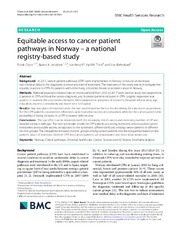Equitable access to cancer patient pathways in Norway – a national registry-based study
Permanent lenke
https://hdl.handle.net/10037/24015Dato
2021-11-25Type
Journal articleTidsskriftartikkel
Peer reviewed
Sammendrag
Methods: National population-based data on individual level from 2015 to 2017 were used to study two proportions; i) patients in CPPs without the cancer diagnosis, and ii) cancer patients included in CPPs. Logistic regression was applied to examine the associations between these proportions and place of residence (hospital referral area), age, education, income, comorbidity and travel time to hospital.
Results: Age and place of residence were the two most important factors for describing the variation in proportions. For the CPP patients, inconsistent differences were found for income and education, while for the cancer patients the probability of being included in a CPP increased with income.
Conclusions: The age effect can be related to both the increasing risk of cancer and increasing number of GP and hospital contacts with age. The non-systematic results for CPP patients according to income and education can be interpreted as equitable access, as opposed to the systematic differences found among cancer patients in different income groups. The inequalities between income groups among cancer patients and the inequalities based on the patients’ place of residence, for both CPP and cancer patients, are unwarranted and need to be addressed.


 English
English norsk
norsk